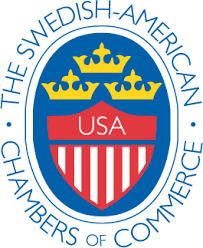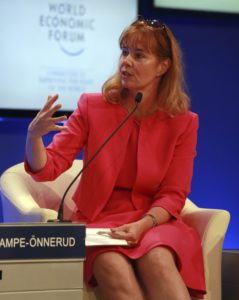In New York: SACCNY: The Global Energy Industry
Media Coverage
Energy entrepreneur Christina Lampe-Onnerud is the Founder and CEO of Connecticut-based Cadenza Innovation, a high-performance, low-cost battery technology company with an initial focus on electric drive and energy storage markets. A veritable powerhouse when it comes to disruptive technology, Christina is a lifetime member of Sweden’s Royal Academy of Engineering Sciences. In 2004 she founded Boston-Power, a maker of lithium ion batteries of laptops and electric vehicles. In 2009, Boston-Power captured the world’s attention when it went to the Paris Auto Show with a 5-passenger SAAB/GM electric vehicle that pioneered 200 mph and 0-100 in 8.5 seconds. Christina has earned numerous accolades throughout her career including, most recently, the CT Technology Council 2015 Women of Innovation: Entrepreneurial Innovation and Leadership Award. Christina was a featured speaker at SACC’s Innovate46 conference last fall, joining Tesla’s Peter Carlsson for a conversation about the latest in battery technology. We sat down with her recently to talk about disruption, the future of batteries, and how her love of classical music informs her work.
Please tell us a little bit about Cadenza Innovation. Where did the idea come from?
It came about on the heels of my time in the global energy industry. I saw an opportunity to bring forward the concept of battery bank energy storage, which ultimately delivers money to all stakeholders in the energy ecosystem. We have been recognized by the New England states for our very profound discoveries around safer batteries. We have the architecture for how you can package energy safely at a very low cost.
Why batteries?
What do you know when you are young? You make some of your biggest decisions in your twenties. School was very easy for me. I wanted to be in an area of disruption. Initially I thought about modified genetics, or genome engineering. But I saw one of the biggest problems was in the area of water/energy. I thought I could do enormous good there, and I went after it wholeheartedly.
You have said, “I think it’s important to take big ideas to market.” What big idea are you working on now?
The big idea is making a piece of the energy economy very accessible, very reliable, and very cheap. This will allow for a more sustainable energy mix. In the energy field, we are pivoting on so many things. Because we are more tied together, we can have big ideas and translate them into big works more quickly.
Where do you see the next significant “paradigm shift” in energy?
The infrastructure that the previous generation put in place – based on fossil fuels – will take a long time to retire, if ever. But what we can do now is affect peak shaping and peak balance. There is a revolution of citizens in the world that are saying, “I can do something about this. I can take myself into a net-zero position on energy.” This in turn gives a person the opportunity to be useful and give to the global economy. The utility providers have a chance to make their operations more efficient. They just need to find a way to store the energy. It is a win-win for everybody.
How does America stack up when it comes to energy awareness?
The average American is typically under appreciated. Scandinavians by and large are more aware of climate change earlier, because they have seen it up close. Here in the U.S., we can’t see it. It’s easy to be a climate change denier. But the U.S. is very progressive when it comes to listening to new ideas. There is always a lot of discussion, but when the U.S. decides to do something, it goes very quickly.
What advice do you have for entrepreneurs?
Always have something new to convey to investors and partners, to add precision to the discussion early on. The challenge for entrepreneurs is: How can you triangulate the future? When you allow for a big change in a paradigm there is no date or very little data. To frame the discussion around that is really an art. I tell people to stress test the idea and engage with as many stakeholders as possible. Now, when I go in to meet potential investors I have started to say, “Of course there are no data. That’s the point.” I‘m a little bit like a bumblebee that way. By physics or construction it can’t fly. I just fly anyway.
We have ready that you are an accomplished cellist. Do you still play? How does music inform your work?
I no longer play the cello but I do direct an all-female 45-piece a capella group. Music is a big deal for me. It allows me to be with a part of the population I so rarely meet in my professional life. Music is just fun. It forces you to be in the moment and let go. The discipline of focus, rehearsal, visual presentation, all of it is helpful in my work. I use that in my business all the time. If you can’t communicate to the instrument, you can’t get your idea across. The same is true with people.
You were a panelist at Innovate46. What did you get out of that experience?
Innovate46 was a well-organized, beautiful platform. It was easy to feel the pulse of the conference. It is always interesting to talk to Tesla. I think it is a luxury to sit down in the audience to hear trends and thoughts, to surrender to the moment and take in what is not usually your reality.
What is next for Cadenza Innovation?
This is going to be a growth year for us. We are taking in outside capital. I think that we are very fortunate to take it to the next level.
IN NEW YORK – No. 1, 2016
IN NEW YORK is the member newsletter of The Swedish American Chamber of Commerce, Inc.

